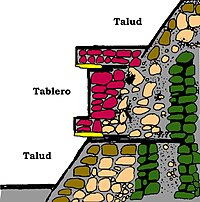



Talud-tablero is an architectural style most commonly used in platforms, temples, and pyramidsinPre-Columbian Mesoamerica, becoming popular in the Early Classic Period of Teotihuacan. Talud-tablero consists of an inward-sloping surface or panel called the talud, with a panel or structure perpendicular to the ground sitting upon the slope called the tablero. This may also be referred to as the slope-and-panel style.
Talud-tablero was often employed in pyramid construction, found in Pre-Columbian Mesoamerica. It is found in many cities and cultures but is strongly associated with the Teotihuacan culture of central Mexico, where it is a dominant architectural style. Talud-tablero's appearance in many cities during and after Teotihuacan's apogee is thought to be indicative of the city's powerful influence in Mesoamerica as a trade, art, and cultural center, with the architectural style serving to either emulate Teotihuacan or affiliate the cities together.[2] Teotihuacan's influence was especially evident in newer settlements that developed during the Early Classic Period, which adopted the talud-tablero architectural style and may have utilized guidance from the city to become trading centers themselves.[3] After the fall of Teotihuacan, other cities may have adopted the talud-tablero style not for its direct affiliation with Teotihuacan, but because of the power it symbolized due to the many successful cultures that had adopted it.[3]
Many different variants on the talud-tablero style arose throughout Mesoamerica, developing and manifesting themselves differently among the various cultures. In some cases, such as the Maya city of Tikal, the introduction of talud-tablero architecture during the Early Classic corresponds with direct contact with Teotihuacan and possible domination or conquest.[4] However, the form of contact at other cities is less well documented and presumably included trade and cultural contacts. A competing theory by Juan Pedro Laporte postulates that Tikal may have developed talud-tablero independently from Teotihuacan based on their extensive use of apron molding in their architecture that may have been a precursor to the slope-and-panel.[5]
The earliest examples of talud-tablero constructions date not from the Teotihuacan Early Classic Period, however, but are found in Pre-Classic constructions in the Tlaxcala-Puebla region,[6] with the oldest known dating to c. 200 BC in the Mexican city of Tlalancaleca. It is unknown if Teotihuacan developed their version of the style based on that of Tlalancaleca or if they did so independently.[7] Teotihuacan strongly influenced many other cities which allowed for the architectural style of talud-tablero to be adapted into these cities all over Mesoamerica. Cities and their structures using talud-tablero include:
Other sites where talud-tablero architecture can be found include but are not limited to:
| Early Classic | Middle Classic | Late Classic | Post Classic |
|---|---|---|---|
| Cholula | Tonina | Mitla | Tulum |
| Becan | Dzibilchaltun | Mexiquito | Tancah |
| Teotihuacan | Chinkultic | Teotenango | Tlatelolco |
| Edzna | Cacaxtla | Tula | Tenochititlan |
| Tepeapulco | Xochicalco | Chichen Itza | |
| Solano | El Ixtepete | ||
| Tikal | Copán | ||
| Monte Albán | |||
| Calixtlahuaca | |||
| Yohulichan | |||
| Ake | |||
| Kaminaljuyu | |||
| Oxkintok | |||
| Matacapan | |||
| Tazumal | |||
| Tingambato | |||
| El Tajín | |||
| Palenque |